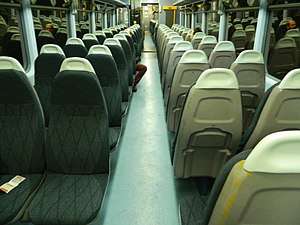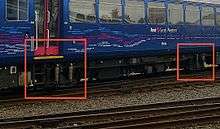British Rail Class 143
The British Rail Class 143 is a diesel multiple unit, part of the Pacer family of trains introduced between 1985 and 1986. They originally worked in the North-East of England but were later transferred to Wales and South-West England.[9]
| British Rail Class 143 Pacer | |
|---|---|
GWR 143603 at Dawlish | |
 Refreshed interior as used in service by Great Western Railway. | |
| In service | 1985 – present |
| Manufacturer | Hunslet-Barclay and Walter Alexander |
| Order no. |
|
| Family name | Pacer |
| Replaced | First generation DMUs |
| Constructed | 1985–1986[1] |
| Entered service | 1985 |
| Refurbished | 1990s/2001–2002[2] |
| Number built | 25 sets |
| Number in service | 18 sets |
| Number preserved | 1 set due |
| Number scrapped | 2 sets (both due to fire) |
| Formation |
|
| Diagram | |
| Fleet numbers |
|
| Capacity |
|
| Operator(s) |
|
| Depot(s) |
|
| Line(s) served |
|
| Specifications | |
| Car body construction | Steel[2] underframe. Aluminium alloy body and roof. |
| Car length | 15.546 m (51 ft 0 in)[3] |
| Width | 2.695 m (8 ft 10 1⁄8 in)[3] |
| Height | 3.515 m (11 ft 6 3⁄8 in)[3] |
| Doors | Twin leaf pivot[2] |
| Articulated sections | 2 |
| Wheelbase | 9.000 m (29 ft 6 3⁄8 in)[3] |
| Maximum speed | 75 mph (121 km/h) |
| Weight |
|
| Prime mover(s) | |
| Engine type | 10-litre[7] turbo-Diesel |
| Cylinder count | 6 |
| Power output | |
| Transmission | |
| Train heating | Engine waste heat, ducted warm air[3] |
| Bogies | None, Ax1[3] fixed axle |
| Braking system(s) | Air[3] |
| Safety system(s) | |
| Coupling system | BSI[8] |
| Multiple working | Classes 14x, 15x and 170[2] |
| Track gauge | 1,435 mm (4 ft 8 1⁄2 in) standard gauge |
Operations
The Rail Vehicle Accessibility (Interoperable Rail System) Regulations 2008[10] and the subsequent Persons of Reduced Mobility - Technical Specification for Interoperability (PRM-TSI) require that all public passenger trains must be accessible by 1 January 2020. No Class 143 train currently meets this requirement. Porterbrook has proposed an extensive refurbishment of the Class 143 and 144 units in an attempt to meet this requirement although this would significantly reduce the number of seats.[11]
Great Western Railway are planning on withdrawing their eight by December 2019 with a cascade programme allowing them to be replaced with Class 150s.[12]
The units are currently used on short distance services around Exeter. Previously they were common on services in the Bristol area.

On 31 December 2019, the Department for Transport issued a dispensation, allowing use of the Class 143 until 31 December 2020 by Great Western Railway.[13]
Incidents
On 17 October 2004, Wessex Trains unit 143613, forming a service from Bristol Temple Meads to Weston-super-Mare with 143621, caught fire between the site of the former Flax Bourton railway station and Nailsea and Backwell. Fire services took two hours to get the blaze under control. Of the 23 passengers and crew, three were treated on-site for the effects of smoke inhalation. One carriage was completely burnt out, and the other was badly damaged, causing the train to be written off.[14] The line through Nailsea was closed until 03:30 the following morning, when the train was hauled to St Philip's Marsh depot for examination.[15] The unit was later taken to Crewe Works where it was stored,[15][16] then later to Cardiff Canton TMD where it was scrapped.[17] The Rail Safety and Standards Board issued a report into the incident, concluding that the fire was caused by electrical arcing between the live starter motor cable (which had damaged insulation) and the unit's underframe, causing accumulated oily residues to ignite.[18]
On 16 January 2020, a Class 143 train had several windows smashed in by waves and sea debris while running along the sea wall at Dawlish during stormy weather, causing minor injuries to one passenger.[19]
Fleet details
| Class | Operator | Number | Year Built | Cars per Set | Unit nos. | Notes |
|---|---|---|---|---|---|---|
| Class 143 | Transport for Wales | 15 | 1985-1986 | 2 | 143601–602/604–610/614/616/622–625 | |
| Great Western Railway | 8 | 143603, 143611–612, 143617–621 | ||||
| Scrapped | 2 | 143613/615 | 143613 & 615 destroyed after fire damage. 613 in 2004 & 615 in 2005. |
| Year | Quantity in service at start of year | Quantity withdrawn | Numbers |
|---|---|---|---|
| 2004 | 25 | 1 | 143613 |
| 2005 | 24 | 1 | 143615 |
Preservation
Presently only one unit has so far been considered as being saved for preservation.
| Set number | Vehicle numbers | Livery | Location | Notes | |
|---|---|---|---|---|---|
| DMS | DMSL | ||||
| 143603 | 55658 | 55669 | Great Western Railway Green | Still in service with Great Western Railway. Will be based at Swindon & Cricklade Railway following withdrawal.[24] | |
Liveries
.jpg) BR Regional Railways blue (Carlisle, undated)
BR Regional Railways blue (Carlisle, undated) BR Regional Railways sector livery (Seaham, 1991)
BR Regional Railways sector livery (Seaham, 1991) Tyne & Wear PTE livery with 'TW Pacer' branding (Seaham, 1991)
Tyne & Wear PTE livery with 'TW Pacer' branding (Seaham, 1991).jpg) Wessex Trains 'Visit Bristol' Bristol Temple Meads, 2005)
Wessex Trains 'Visit Bristol' Bristol Temple Meads, 2005)- Wales and Borders 'Valley Lines' with later Arriva branding (Gloucester, 2005)
- Arriva Trains Wales (Cardiff Central, 2009)
.jpg) First Great Western Bristol Temple Meads, 2008)
First Great Western Bristol Temple Meads, 2008).jpg) First Great Western Bristol Temple Meads, 2009)
First Great Western Bristol Temple Meads, 2009).jpg) Arriva Trains Wales 'Executive' (Cardiff Central, 2016)
Arriva Trains Wales 'Executive' (Cardiff Central, 2016)- Great Western Railway (Exeter, 2017)
Interiors
 Arriva Trains Wales Cab
Arriva Trains Wales Cab Wessex Trains
Wessex Trains- Wales and West 'Valley Lines'
- Arriva Trains Wales
- First Great Western
 Great Western Railway
Great Western Railway
References
- Fox 1987, p. 41
- "Class 143". The Railway Centre. Archived from the original on 9 March 2005.
- Vehicle Diagram Book No. 220 for Diesel Multiple Unit Trains (Railcars) (PDF). Barrowmore MRG. Derby: British Railways Board. 1982. DP236, DP237.
- Fox 1987, pp. 41-42
- Fox & Hughes 1994, p. 26
- "Fleet lists: Class 143". thejunction.org. Archived from the original on 17 January 2007.
- Pritchard & Fox 2009, p. 14
- "System Data for Mechanical and Electrical Coupling of Rail Vehicles". Rail Safety and Standards Board. Archived from the original on 5 July 2008. Retrieved 5 January 2009.
- "Class 143". The Railway Centre. Archived from the original on 8 March 2005.
- "The Rail Vehicle Accessibility (Interoperable Rail System) Regulations 2008".
- "Archived copy" (PDF). Archived from the original (PDF) on 11 March 2014. Retrieved 11 March 2014.CS1 maint: archived copy as title (link)
- "Modernising the Great Western railway" (PDF). p. 49.
- https://assets.publishing.service.gov.uk/government/uploads/system/uploads/attachment_data/file/855277/gwr-class-143-2020-dispensation-letter-timed-request.pdf
- "Commuters escape from train blaze". BBC News. 19 October 2004. Retrieved 20 April 2012.
- "December 2004 magazine". Cardiff & Avonside Railway Society. December 2004. Retrieved 27 April 2012.
A serious incident just short of Nailsea & Backwell station (alongside the common), saw the 2W63 20.06 Temple Meads-Weston-super-Mare local Wessex Trains service, formed with 143613 + 143621, stopped and evacuated due to a fire which gutted coach 55654 and smoke damaged 55679 (both from set 143613). Fire services took two hours to get the blaze under control, the flames reaching around 20 feet in height, but there were no serious injuries, three persons being treated for smoke inhalation of the 23 passengers and crew travelling on the service. The mainline was closed until 03.30 the following day, the units being dragged back to Bristol and store at St.Phillips Marsh depot for examination. The fire was thought to have started due to a mechanical fault. 19/10 143613 was taken to St Phillips Marsh for an investigation into the fire. The main frame of 55654 was badly buckled and it is beyond repair. The unit was taken by road to Crewe Works later in the week.
- "November 2005". Cardiff & Avonside Railway Society. November 2005. Retrieved 17 June 2012.
Stored: 143613/615 - ZC [Crewe Works]
- "September 2006". Cardiff & Avonside Railway Society. September 2006. Retrieved 17 June 2012.
Disposals: Pullman : 143613 @CF [Cardiff Canton]
- "August 2005 section: "Miscellaneous"". Cardiff & Avonside Railway Society. August 2005. Retrieved 27 April 2012.
- "Passenger hurt when wave smashes Great Western Railway train windows". BBC News. 16 January 2020. Retrieved 16 January 2020.
- "DMU FORMATIONS". AbRail. Archived from the original on 29 October 2017. Retrieved 27 March 2015.
- "Class 143". Retrieved 22 August 2018.
- "Class 143". Retrieved 22 August 2018.
- "Class 143". Retrieved 22 August 2018.
- Pacer Preservation Plans Railways Illustrated issue 199 September 2019 page 6
Sources
- Fox, Peter (1987). Multiple Unit Pocket Book. British Railways Pocket Book No.2 (Summer/Autumn 1987 ed.). Platform 5 Publishing Ltd. ISBN 0906579740. OCLC 613347580.CS1 maint: ref=harv (link)
- Fox, Peter; Hughes, Barry (1994). DMUs & Channel Tunnel Stock. British Railways Pocket Book No.3 (7th ed.). Platform 5. ISBN 9781872524597.CS1 maint: ref=harv (link)
- Pritchard, R.N.; Fox, Peter (2009). Diesel Multiple Units 2010. British Railways Pocket Book No.3. Platform 5. ISBN 978-1-902336-75-6. OCLC 614300319.CS1 maint: ref=harv (link)
| Wikimedia Commons has media related to British Rail Class 143. |

